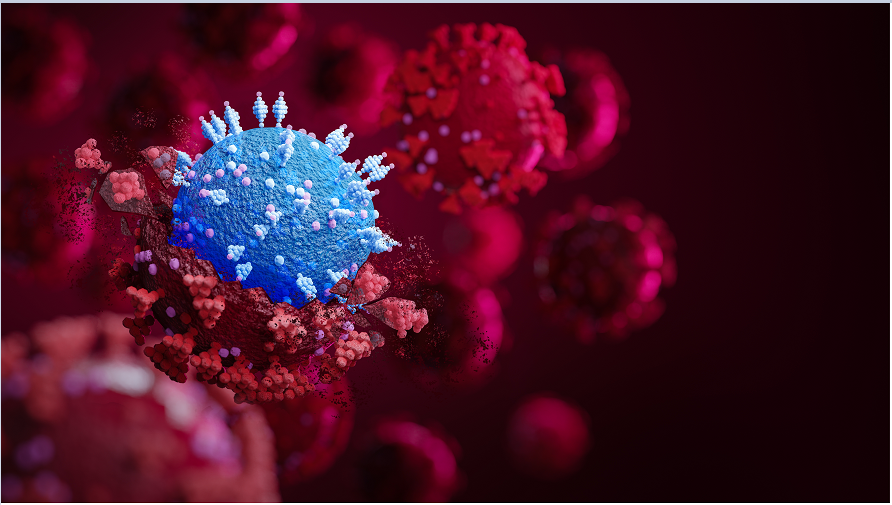Since the beginning of the epidemic, the new coronavirus (SAR-CoV-2), the pathogen of COVID-19, has continuously evolved and mutated, producing mutant strains with enhanced transmission and virulence, such as Alpha (B.1.1.7) and Beta (B. .1.351), Gamma (P.1), Delta (B.1.617.2) and Omicron (B.1.1.529) variants. South Africa first reported the infection of the Omicron variant strain to the WHO on November 24, 2021. Since then, the variant strain has quickly become the main epidemic strain in South Africa and has spread to many countries and regions around the world. On November 24, 2021, the WHO Virus Evolution Technology Steering Group listed it as a variant of concern, and on November 26, it was further classified as a variant of concern (VOC). Preliminary evidence shows that compared with other VOCs, the risk of re-infection with Omicron variants is increased, which poses a new challenge to the prevention and control of the global COVID-19 epidemic. Therefore, this article summarizes the research progress on the pathogenic characteristics and source of mutation of Omicron mutant strains.
Pathogenic Characteristics of Omicron Variants
The Omicron (B.1.1.529) variant strain comes from the B.1.1 lineage and belongs to the same lineage as Alpha (B.1.1.7), and is one of the evolutionary lines of SARS-CoV-2. SARS-CoV-2 is a round or oval β-coronavirus with envelope, with a diameter of 60~140 nm. Gene sequencing revealed that the genome of SARS-CoV-2 includes two flanking untranslated regions (5′-UTR and 3′-UTR) and a long open reading frame (ORF) encoding multiple proteins. The first 5′-ORF (ORF1a/b) encodes the formation of 16 non-structural proteins (nsp1-16), and the 3′-ORF encodes auxiliary and structural proteins. Structural proteins include spike protein S, envelope protein E, matrix protein M, and nucleocapsid protein N. The surface protein S is composed of S1 and S2 subunits, which can recognize and bind to host cell receptors (Angiotensin Converting Enzyme 2, ACE2), and mediate the penetration of viruses into host cells.

At present, researchers have sequenced the genome of the Omicron variant from Botswana and found that the spike protein S of this variant has more than 30 mutations, including A67V, T95I, Δ211/L212I, G339D and other mutations. The protein can recognize host cells and is the main target of the human immune response. The receptor binding domain (RBD) is the part of the virus that first contacts the cell. Researchers have found 15 mutations in the RBD of the Omicron mutant, including K417N, S477N, T478K, E484A, N501Y, G339D, S371L, S373P, S375F, N440K, G446S, Q493R, G496S, Q498R and Y505H. The number of mutations far exceeds the 2 mutations of the Delta variant that quickly spread to become the main global epidemic earlier this year. The mutation of the Omicron mutant has multiple overlaps with the Delta and Alpha mutants, and is related to increased infectivity and the ability to evade infection blocking antibodies. Most vaccines rely on spike proteins to activate immune cells against SARS-CoV-2, so the Omicron mutant strain may have far more infection and transmission capabilities than the Delta mutant strain.
Sources of Variation of Omicron Mutants
According to the SARS-CoV-2 database information currently shared by the GISAID platform, the number of mutation sites of the Omicron mutant strain is significantly greater than that of all SARS-CoV-2 mutant strains that have been circulating in the past two years, especially the virus spike protein has more mutations. It is speculated that there may be three reasons for its emergence: (1) SARSCoV-2 in chronically infected persons with COVID-19 has undergone a long period of evolution, accumulated a large number of mutations, and spread by chance. (2) A certain animal group is infected with SARS-CoV-2. The virus has undergone adaptive evolution during the spread of the animal group, and the mutation rate is higher than that of humans, and then spilled into humans. SARS-CoV-2 is a promiscuous virus that can infect rodents, cats, dogs, white-tailed deer and other animals. Some experts believe that SARS-CoV-2 may be hidden in rodents or other animals, so it has experienced different evolutionary pressures, selected new mutations, and then may re-enter humans as a different virus. (3) The mutant strains spread and evolve in people who lack monitoring and gene sequencing. Due to insufficient monitoring capabilities, the intermediate generation viruses of their evolution have not been discovered in time. Christian Drosten, a German virologist, believes that the mutant strain did not evolve in South Africa because South Africa has been doing a lot of gene sequencing work. The mutant strain evolved in some countries in southern Africa that did not perform gene sequencing. But some other experts believe that it is difficult to have enough isolation in the world to allow the virus to evolve for a long time without spreading to other places.
